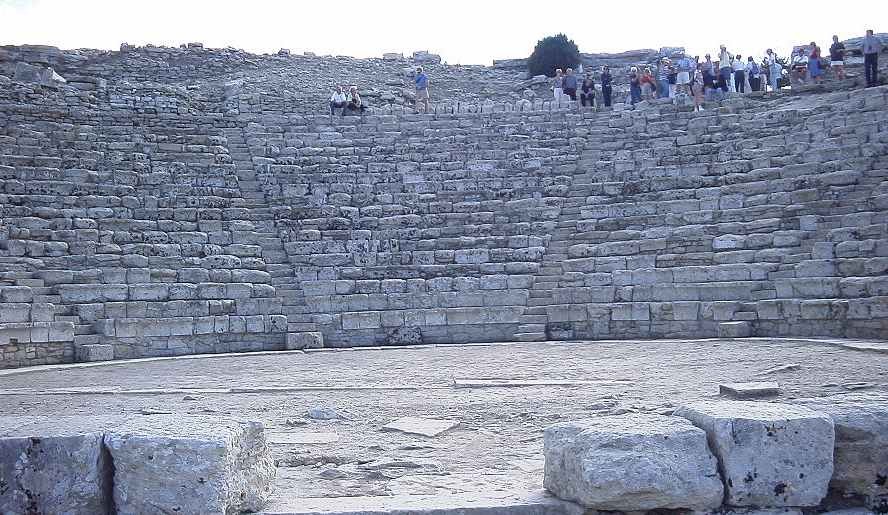
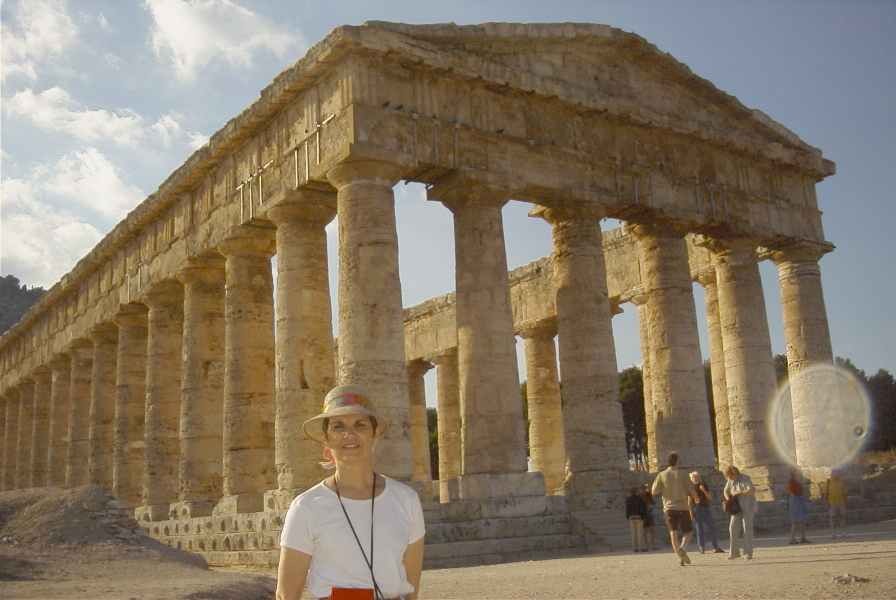 The golden limestoned Temple of
Segasta with the Golden Girl Pietrina. Her halo got tired and
drifted away. Maybe the goddess of this temple was working
some magic still!
The golden limestoned Temple of
Segasta with the Golden Girl Pietrina. Her halo got tired and
drifted away. Maybe the goddess of this temple was working
some magic still!
After Selinunte we ventured northward and upward to Segasta, Selinunte's old rival and a major town in the Mediterranean. Although the place was built by one of the three indigenous peoples of Sicily (called the Elami), the town got caught up in the politics of Greece and Carthage and got wiped out, only to rise again under the Romans. While the place is now abandoned except for tourist buses today, it was populated from pre-historic times (legend has it that it held Trojans left by Aeneas) through the middle ages when the Saracens and the Vandals vandalized and saracenized it. Later the Normans built several buildings that are now piles of rocks.
We started by climbing Mount Barbaro (Mount Barbarian) up about 1300 feet to see the 3C BC Greek theater hewn from the rocks during the Roman days!

Like a lot of the better preserved Greek theaters (Sicily has lots of them), this space is still used to stage drama, in this case, every two years Greek plays (in Italian) are revived here.
As you can see from this full frontal view, the place is still in good enough shape to house an audience although I'm not sure I'd want to sit on those seats for any great length of time even though I carry a lot of my own padding just for such contingency. Say "hi" to our tour group in the upper right of the picture. They had to sit on bus seats that were slightly more comfortable than these rocks but had much less leg room.
As you can see, this theater is a classic semi-circle which allowed the audience a beautiful view of what goes on behind the stage. (Greek dramas started out as religious dancing which could go on a long time and were held during the daytime so it's not impossible that some of the spectators would be more interested in the distant vista than in what was going on on stage.) Here's the view they'd have:
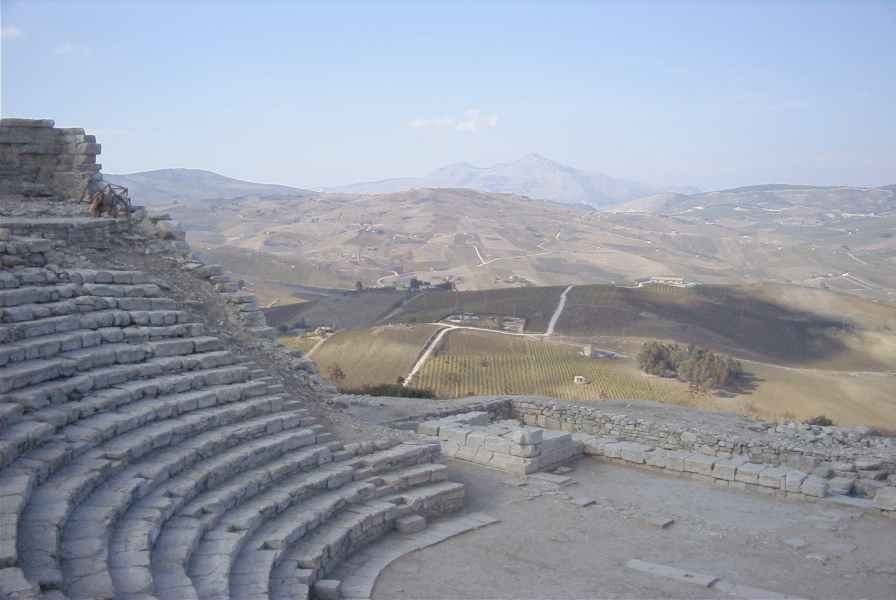
Looking stage right, the spectators could see, on a clear day, all the way to Sicily's largest bay. You'll have to settle for the stage left view of the fertile Sicilian farmland rolling to the distant mountain.
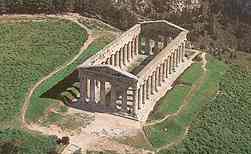
If you don't count souvenir stores, the only other spot in town is the temple, but it's a good one. Because it was never finished, it was never destroyed. (If you're into destroying the previous owner's gods, you don't bother messing with unfinished temples.) As you can see from the picture at the top of the page and the aerial view just above, the overall shape of the temple, including its 36 columns, has been preserved despite the attempts by Vandals, earthquakes, and the Spanish Inquisition to rewrite history:
Ironically, because it was never finished, it is now one of the best preserved buildings of the ancient world and this golden limestone building stands majestically among the green mountains surrounding it with virtually nothing else man-made in sight.
Our guide was able to use this temple to show us more about Greek building techniques: How they used lead between the blocks on the pillars (most pillars are stacks of large blocks in the shape of bass drums). When the "stack" was finished, the ancient builders would then smooth the outside of the pillar with cement (called "fluting"), giving it a ribbed shape that made the column look like a single piece of stone. In the case of this temple, the building was never finished, so we can clearly see the stack of stones. (There is some debate as to whether the building was really meant to be finished).
The guide also showed how two columns when erected would form the outline of a Greek water jar as, hopefully, you can see in the picture below. Note also the stacked "drums" of the columns and imagine the slices of lead between them like gaskets to get the two rough hewn stone faces to sit on top of each other. This may have absorbed some of the shocks of the inevitable earthquakes in Sicily. The African and European plates continues to move under Sicily at this point making the earth creak and moan through Etna's throat.
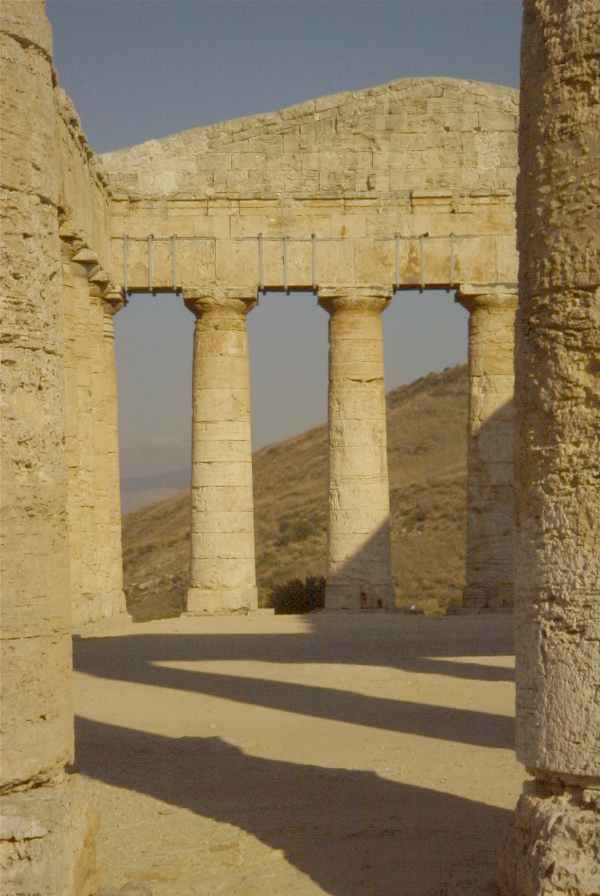
After Segasta, we ventured back the 45 miles or so to Palermo for dinner and a night of Sicilian folks dancing and puppetry. The next day we ventured to Agrigento and the "valley" of the temples. Please join us by clicking here.
Where do you want to go today? Here's a few choices:
